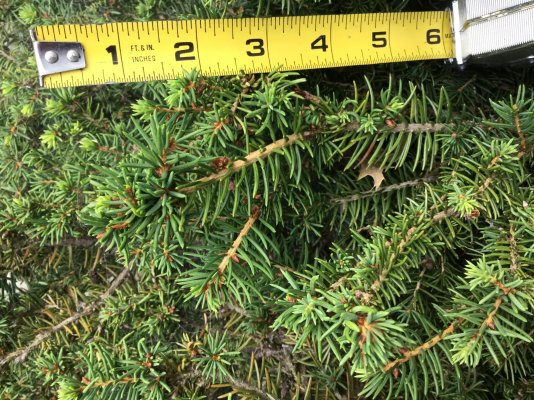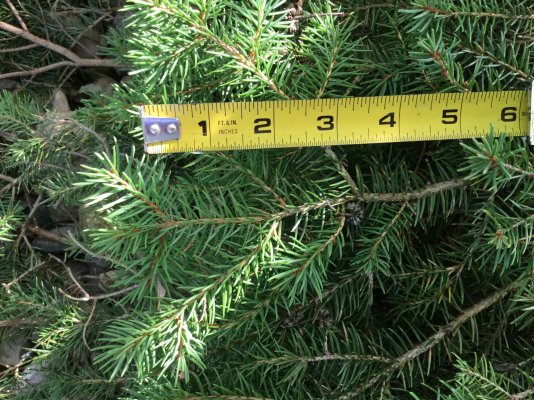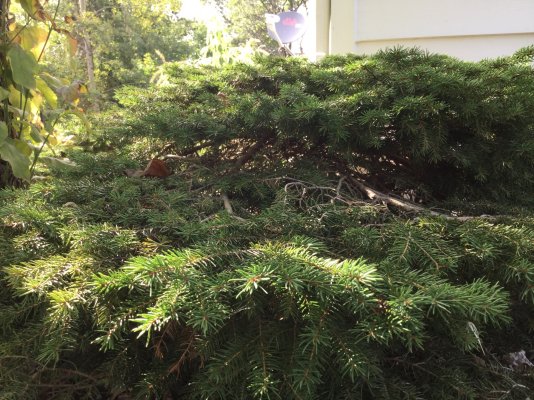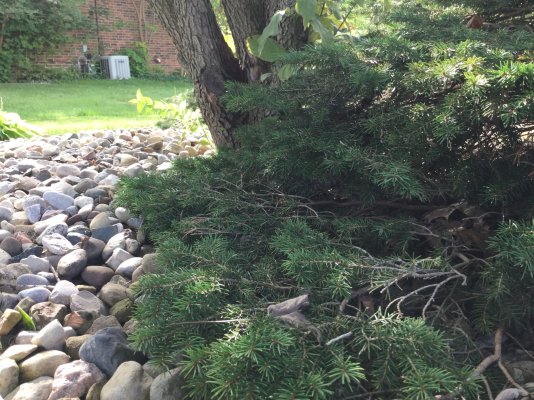You're so welcome! Plant ID is a hobby of mine. I taught two semesters at the same community college where I got my hort degree. Never taught college before-it was a blast! The bluish dense one is Blue Star Juniper (Juniperus squamata 'Blue Star'. Great plant! The other two dwarf conifers are tough for me. Not Junipers, may be some kind of dwarf firs. The grass I will have to work on. Does it bloom at all? That will help me. This is fun!Thank you very much! You're very kind. They're undoubtedly easy ones, I'm just that clueless. DW identified most of the others. She thinks the first three are some kind of yews. The last must be very common, she just doesn't know off the top of her head, she's best with flowering plants.
My decidedly amateur notes:
Pic 1: Some dwarf variety. Chosen to stay very small, about 18" across after 10+ years. Small light/mint green needles. Very dense.
Pic 2: Moderate size, 2-3 foot, typical green needles, average density. Nothing special, prob common.
Pic 3: Has remained small, low flat thin layering branches. Pic doesn't show the layering well.
Pic 4: A dwarf grass, less than 18" across after 10+ years. Chosen to remain very small, and they have.
You are using an out of date browser. It may not display this or other websites correctly.
You should upgrade or use an alternative browser.
You should upgrade or use an alternative browser.
Benefit #47 of 50 in retirement
- Thread starter Midpack
- Start date
Lawrencewendall
Full time employment: Posting here.
Thank you very much! You're very kind. They're undoubtedly easy ones, I'm just that clueless. DW identified most of the others. She thinks the first three are some kind of yews. The last must be very common, she just doesn't know off the top of her head, she's best with flowering plants.
My decidedly amateur notes:
Pic 1: Some dwarf variety. Chosen to stay very small, about 18" across after 10+ years. Small light/mint green needles. Very dense.
Pic 2: Moderate size, 2-3 foot, typical green needles, average density. Nothing special, prob common.
Pic 3: Has remained small, low flat thin layering branches. Pic doesn't show the layering well.
Pic 4: A dwarf grass, less than 18" across after 10+ years. Chosen to remain very small, and they have.
Pic 4 I think is Chinese ornamental grass.
Pic 4 I think is Chinese ornamental grass.
May be Liriope muscari, or Lilyturf. Google images. Sometimes they don't bloom if conditions aren't right.
Midpack
Give me a museum and I'll fill it. (Picasso) Give me a forum ...
You're so welcome! Plant ID is a hobby of mine. I taught two semesters at the same community college where I got my hort degree. Never taught college before-it was a blast! The bluish dense one is Blue Star Juniper (Juniperus squamata 'Blue Star'. Great plant! The other two dwarf conifers are tough for me. Not Junipers, may be some kind of dwarf firs. The grass I will have to work on. Does it bloom at all? That will help me. This is fun!
Pic 4 I think is Chinese ornamental grass.
May be Liriope muscari, or Lilyturf. Google images. Sometimes they don't bloom if conditions aren't right.
Agree with Mango, # 1 is Blue Star Juniper. Have to go to a computer where I can see 2 & 3 better. Is # 4 liriope?
- I am sure you're right on #1, Blue Star Juniper. One of my favorite plants in our yard.
- For some reason we think we were told #2 is a yew, but not positive. It's an ordinary shrub, not large but not a dwarf IMHO.
- I wish I could get a better pic of #3. It hugs the ground, stays smallish but the branches must be a huge clue. Broad, flat and distinct layers unlike most shrubs I've seen.
- The liriope muscari description reads right except the description I found said 1" wide leaves - they're no more than 1/2" wide if that. It dies off in winter, and comes back in spring. Sadly I just don't remember if it blooms later.

Again, I'm grateful to know and fill out my landscape diagram. We expect to move in the next few years, and we'll want some of the same plantings!
Last edited:
liriope leaves are "up to 1" wide", muscari blooms in August so you'll be able to see if it blooms, soon. #3 could be Birds Nest Spruce that's getting too much shade. Can't see enough detail on pic #2. Mango, your thoughts on #3, Birds Nest
liriope leaves are "up to 1" wide", muscari blooms in August so you'll be able to see if it blooms, soon. #3 could be Birds Nest Spruce that's getting too much shade. Can't see enough detail on pic #2. Mango, your thoughts on #3, Birds Nest
The leaf arrangement makes me think Dwarf Plum Yew on number 2 (Cephalotaxus harringtonia 'Nana') Number 3 still eludes me. I'm used to seeing Bird's Nest Spruce much tighter and denser (at least here in Northern Calif, inland, Zone 9) so I am thinking it's not it. Funny, I'm a bit of a conifer nerd-for Christmas years ago, DH got me the two volume set "Conifers-the Illustrated Encyclopedia." This post got me looking at these volumes again, which is great! It's possible that number three is either a dwarf Yew, Fir, or dwarf Douglas Fir, or even a Hemlock! There are a host of dwarf conifers available in nurseries. In the Chicago area, there could be commonly only a few available and sold in nurseries. If Midpack wants to replicate the "look" of number 3, I'm sure that a knowledgeable nursery would be able to supply something. One way to tell a Yew needle from a Fir or Hemlock is the Yew needle will not have a white stripe on the bottom of the needle. Midpack, can you go check?
Midpack
Give me a museum and I'll fill it. (Picasso) Give me a forum ...
Of course, happy to check, get more pictures, whatever might help.The leaf arrangement makes me think Dwarf Plum Yew on number 2 (Cephalotaxus harringtonia 'Nana') Number 3 still eludes me. I'm used to seeing Bird's Nest Spruce much tighter and denser (at least here in Northern Calif, inland, Zone 9) so I am thinking it's not it. Funny, I'm a bit of a conifer nerd-for Christmas years ago, DH got me the two volume set "Conifers-the Illustrated Encyclopedia." This post got me looking at these volumes again, which is great! It's possible that number three is either a dwarf Yew, Fir, or dwarf Douglas Fir, or even a Hemlock! There are a host of dwarf conifers available in nurseries. In the Chicago area, there could be commonly only a few available and sold in nurseries. If Midpack wants to replicate the "look" of number 3, I'm sure that a knowledgeable nursery would be able to supply something. One way to tell a Yew needle from a Fir or Hemlock is the Yew needle will not have a white stripe on the bottom of the needle. Midpack, can you go check?
There are no white stripes on the needles for #2 or #3. And the needles on #2 are longer and flatter than on our blue star junipers or our juniper gold cones. The needles on #3 are still longer, also flatter than our junipers.
#2 has to be common around here, Chicagoland. It grows round, up and out like most shrubs, but unlike #3.
#3 is planted behind and under a dogwood, next to the house (it was there when we bought the house). Seems a poor location choice, but it's 30 years old now. It grows horizontally, not up but not ground cover low either. There are two, maybe 18" tall if that but a good 6' across!
Below:
- Closeup on #2.
- Closeup on #3.
- Two more pics of #3 trying to show the layered or tiered branches. Where the branches grow in three dimensions on all our other conifers, the branches on #3 grow in two dimensions horizontal or flat. I'm not explaining well.
Attachments
Last edited:
Midpack
Give me a museum and I'll fill it. (Picasso) Give me a forum ...
Not that you need it but I reported to DW. I pointed to the Liriope Muscari, Blue Lilyturf and she immediately remembered 'yes.' Before I said it, she said it has blue blooms in August (I didn't remember).
And when I pointed to the Blue Star Junipers, she also immediately remembered 'yes.'
Exciting for me anyway!
And when I pointed to the Blue Star Junipers, she also immediately remembered 'yes.'
Exciting for me anyway!
Not that you need it but I reported to DW. I pointed to the Liriope Muscari, Blue Lilyturf and she immediately remembered 'yes.' Before I said it, she said it has blue blooms in August (I didn't remember).
And when I pointed to the Blue Star Junipers, she also immediately remembered 'yes.'
Exciting for me anyway!
Yay! Good to hear!
Of course, happy to check, get more pictures, whatever might help.
There are no white stripes on the needles for #2 or #3. And the needles on #2 are longer and flatter than on our blue star junipers or our juniper gold cones. The needles on #3 are still longer, also flatter than our junipers.
#2 has to be common around here, Chicagoland. It grows round, up and out like most shrubs, but unlike #3.
#3 is planted behind and under a dogwood, next to the house (it was there when we bought the house). Seems a poor location choice, but it's 30 years old now. It grows horizontally, not up but not ground cover low either. There are two, maybe 18" tall if that but a good 6' across!
Below:
- Closeup on #2.
- Closeup on #3.
- Two more pics of #3 trying to show the layered or tiered branches. Where the branches grow in three dimensions on all our other conifers, the branches on #3 grow in two dimensions horizontal or flat. I'm not explaining well.
After more research on the needle anatomy, I'm going to say you have two different dwarf Yews. Not sure on the cultivar names, but that may be enough for you to complete your diagram. Here's a quote from a conifer ID website on the Yew needle anatomy: "The NEEDLES are flat, half-inch to an inch long, but have no white lines on the undersides. The tips are sharply pointed, where the fir and hemlock tend to be rounded. Yew will often form straggly THICKETS in the understory of northern hardwood stands. The red berry-like FRUITS are about a 1/4-inch in size, each containing a pit."
If no evidence of fruit (last year's seed pod maybe) maybe it's a male and not a female specimen (
Similar threads
- Replies
- 48
- Views
- 6K
- Replies
- 27
- Views
- 5K
- Replies
- 95
- Views
- 14K




